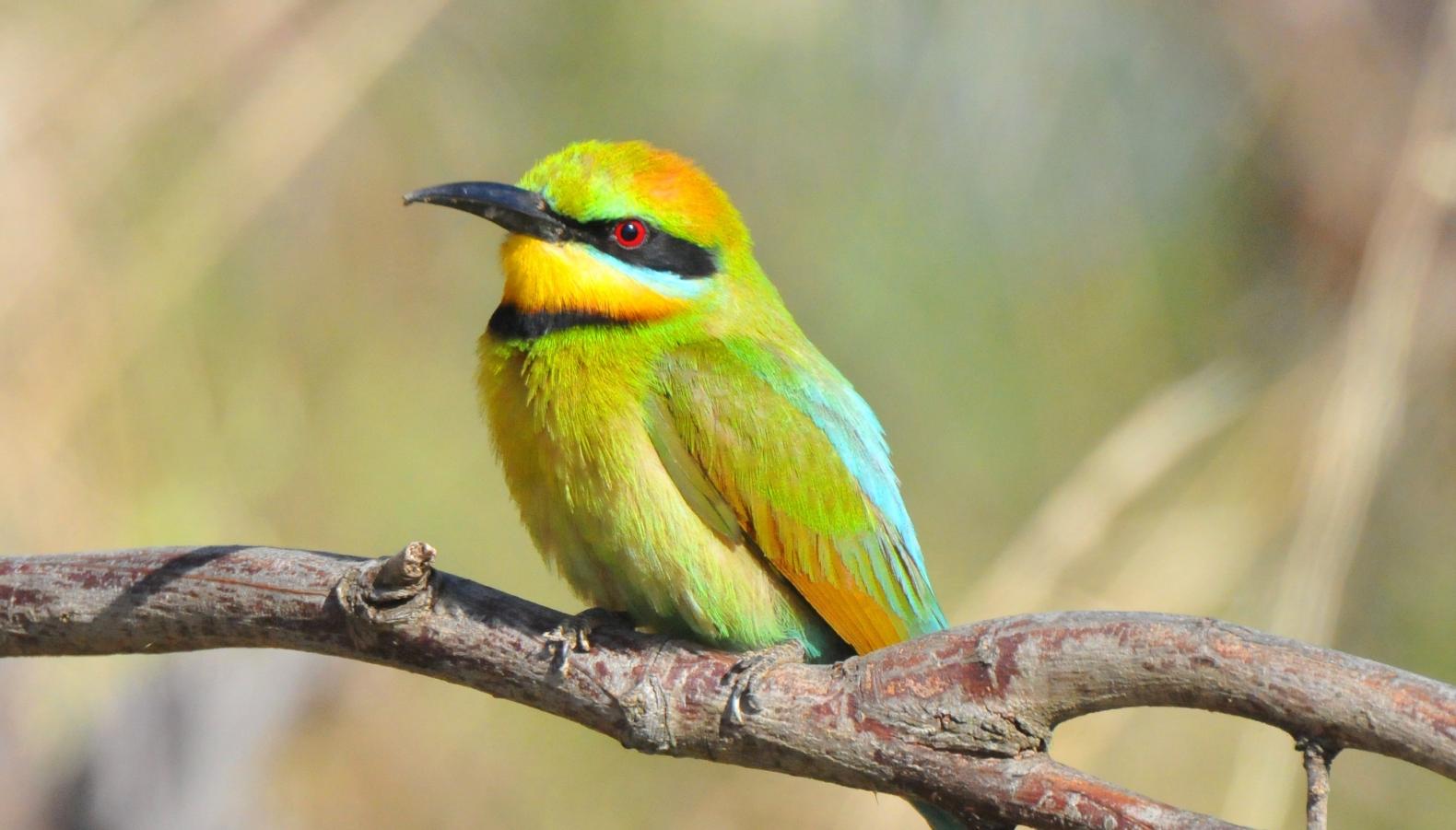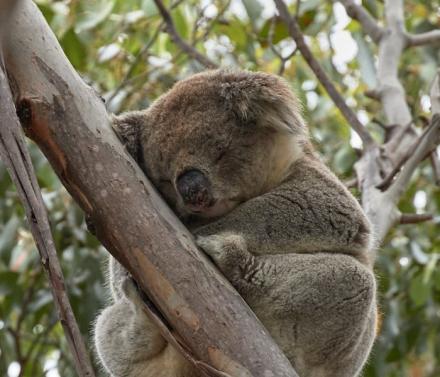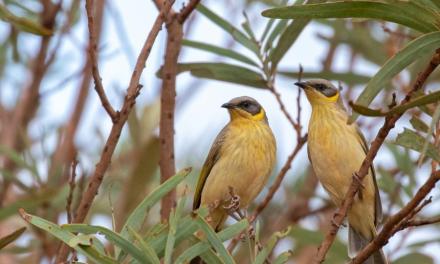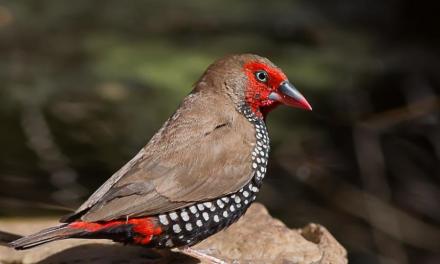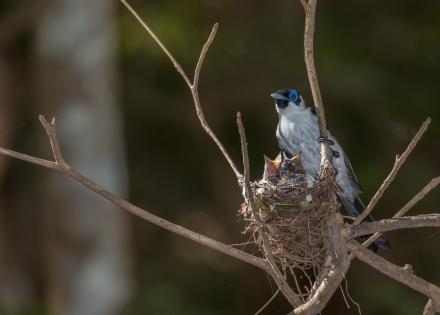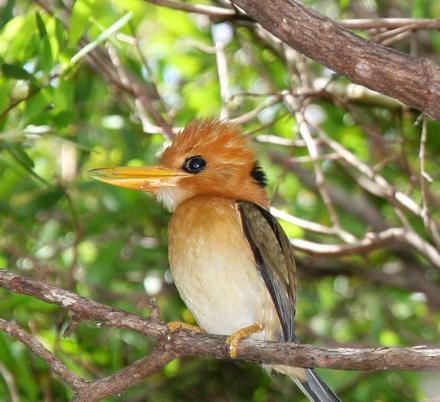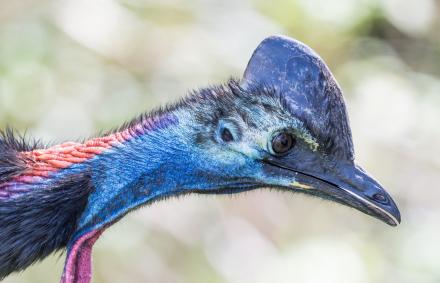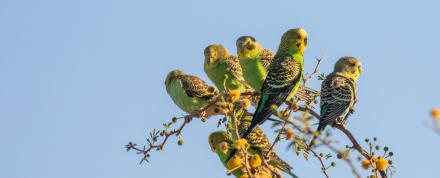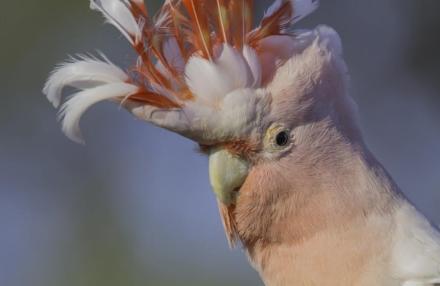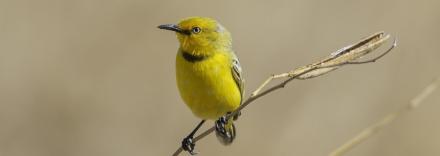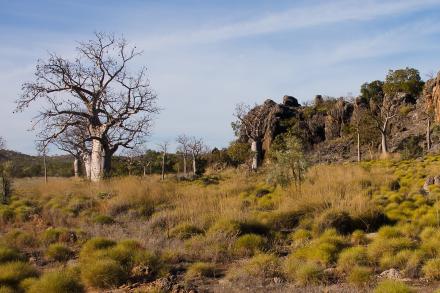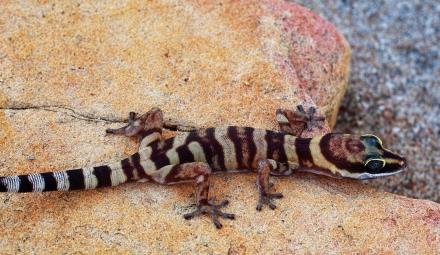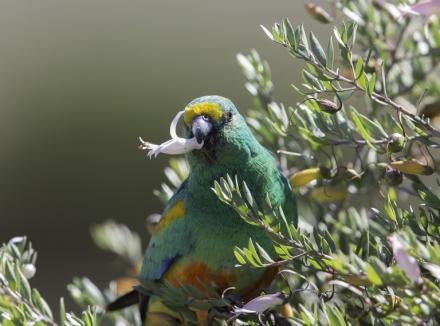Take our new wildlife guided tour in Outback Australia that takes us to the red dunes and isolated waterholes of the remote Southwest corner of Queensland.
We are excited to offer this new Outback adventure that takes us to the red dunes and isolated waterholes of the remote South-west corner of Queensland. Beginning in Mt Isa and ending in Longreach, the tour takes us to the Channel Country and Mulga Lands to look for inland rarities and difficult-to-find species such as Eyrean and Grey Grasswrens, Grey Falcon and Letter-winged Kite. We will visit iconic landscapes and historic towns. A highlight of the tour is a visit to Bowra Wildlife Sanctuary, a world-renowned birding location known for its diversity and rare species.
This tour is designed to join Inala’s Outback Queensland: Birds, Mammals and Australia’s Ancient Creatures, 15 – 25 June 2024.
10 nights’ accommodation, specialist guides and transport, meals, entrance fees and activities as mentioned in the itinerary including fossicking licenses if required.
International and domestic airfares, gratuities, alcoholic beverages, snacks, internet, laundry or other items of a personal nature.
Meals and drinks: Breakfast generally consists of a continental style breakfast with cereal, fruit and yoghurt and tea/coffee. Full cooked breakfast is not generally offered at most locations. Lunch will generally consist of a packed lunch style meal eaten in the field, with sandwich/filled roll, fruit, and a drink. Dinner usually consists of several options for main with the choice of either an appetiser or dessert. Drinks (soft and alcoholic) are generally not included but at lunches and breakfasts juice may be made available.
The itinerary: Whilst we aim to follow the itinerary as planned, please note that the itinerary provided should only be used as a guideline. Depending on individual trip circumstances, weather, and local information, the exact itinerary may not be strictly adhered to. The guides reserve the right to make changes to the itinerary as they see fit.
Remoteness: Please note that for much of this tour we will be birding in a wonderful yet remote part of Australia. Many of the roads are unsealed and rough and travel will be in 4WD vehicles. If you have medical conditions or health concerns, it is important you make us aware of these in advance of this tour. We will also be travelling long distances on some days.
Download the itinerary brochure for the South-west Queensland - Birds & Wildlife of the Remote Outback tour.
Download (pdf 848.1 KB)There are terms and conditions relating to payments, cancellations, refunds, insurance and responsibility for our tours.
Here's what you'll see and do on the South-west Queensland - Birds & Wildlife of the Remote Outback tour.
Today has been set aside as an arrival day. Meet at 19:00 for a group welcome dinner, meet your guides and chat about the details for the tour.
Accommodation: Mt Isa (en suite rooms)
Meals included: D
An early start today with a visit to the rocky gorges around Mount Isa to look for Kalkadoon Grasswren, the Golden-backed form (laetior) of the Black-chinned Honeyeater, Red-winged Parrot, Spotted Bowerbird and other dry country birds. There is also a good chance of seeing Purple-necked Rock-wallaby, which is restricted to the rocky ranges of NW Queensland.
After breakfast we will travel to Boulia (a total of around 4 hours’ drive), birding en route. Species we will be searching for include Black and Grey Falcon, Red Goshawk, Rufous-crowned Emu-wren and Ground Cuckoo-shrike. We should also see Red-browed Pardalote, Budgerigar and Wedge-tailed eagle. Little Button-quail has also been seen on our past tours there.
This afternoon we will visit the Boulia Marine Fossil display. There will also be an opportunity to bird in the area (Brolga, Rufous Songlark, Cloncurry form of Australian Ringneck and Mistletoebird).
Accommodation: Boulia (en suite rooms)
Meals included: B L D
Today we drive south on the through the Channel Country. Our destination is Birdsville, one of Queensland’s most famous Outback towns. We will stop along the way at river crossings to look for Black-eared Cuckoo, Black Honeyeater, Brown and Rufous Songlark, and nomadic flocks of Cockatiel. On arrival at Birdsville we will check into our accommodation and explore the town.
Accommodation: Birdsville (en suite rooms)
Meals included: B L D
We’ll have a full day to explore this area, with excursions out to the west and north to look for a few star specials of the region. To the west is the mighty Simpson Desert with its enormous red sand dunes, and here we’ll look for Eyrean Grasswren in the canegrass amongst the swales. This is a charismatic and active species, however we will need to sit quietly amongst their chosen habitat for the best chances of a look. Out on the lignum flats to the north of Birdsville we’ll have a try for Grey Grasswren, an extremely elusive bird that is entirely restricted to the lignum floodplains of the lower Eyrean basin of the corner country where NSW, QLD & SA meet.
Mammals we should see include Red Kangaroo, Western Grey Kangaroo and Common Wallaroo (Euro). At night we can head out with spotlights in hand to look for night birds such as Spotted Nightjar, Australian Owlet-nightjar and Australian Boobook, and for critters like Dusky Hopping Mouse, Smooth Knob-tailed Geckos and Broad-banded Sand-swimmers. Australia’s biggest goanna, the Perentie, is also a chance here.
Accommodation: Birdsville (en suite rooms)
Meals included: B L D
We will spend another morning in Birdville to pick up anything we might be missing before heading toward Windorah. As we travel east out of Birdsville, we cross the Sturt Stony Desert – a vast, open and mostly treeless landscape consisting of the small, pebbly substrate known as gibber.
We’ll have a chance of the fascinating Gibberbird in this environment, as well as the possibility of Cinnamon Quail-thrush, Inland Dotterel, Australian Pratincole, Australian Bustard, White-backed Swallow, Australian (Gull-billed) Tern, Banded Lapwing, Little Button-quail, Australian Ringneck, Chestnut-rumped Thornbill, Southern Whiteface, Apostlebird, Australian Raven and Little Crow. Depending on whether rain has fallen recently, there may be small numbers of the highly nomadic Flock Bronzewing present in the area as well. Diurnal reptiles will hopefully be out and about, and we’ll keep eyes peeled for Mulga Snake, Central Bearded Dragon and Gould’s Monitor.
The afternoon will involve a bit of driving but, as always, we’ll have stops along the way. Birds we may have not seen yet include the likes of Pallid Cuckoo, Horsfield’s Bronze-cuckoo, Purple-backed Fairywren, Inland Thornbill, Varied Sittella, Crested Bellbird, White-fronted, Singing and Spiny-cheeked Honeyeaters, and Black-faced Woodswallow.
Accommodation: Windorah (en suite rooms)
Meals included: B L D
After a pre-breakfast look along Cooper Creek, we’ll leave Windorah and head south, stopping en route for birds and wildlife along the way. We may see our Australian Bustards today, as well as chances of mixed flocks of White-browed and Masked Wooodswallows, White-winged Triller, Rufous Songlark, Blue Bonnet, Mulga Parrot, Spotted Bowerbird, Red-browed Pardalote and hopefully if there has been recent rain – Pied and Black Honeyeaters in flowering Eremophila shrubs. Raptors should be well-represented, with Black Falcon, Black-breasted Buzzard, Spotted Harrier, Little Eagle, Wedge-tailed Eagle, Black and Whistling Kites and the ever-present chance of Grey Falcon or even Letter-winged Kite.
We will stop at the tiny Outback village of Eromanga with its amazing fossil museum. The town lies on Cretaceous Eromanga Sea and fossils of dinosaurs and more recent megafauna have been excavated in the area. We will stay overnight at Quilpie on the Bulloo River. If time permits, we will visit St Finbarr’s Church to view the precious opal altar or fossick for our own opals at the edge of town.
Accommodation: Quilpie (hotel en suite rooms)
Meals included: B L D
Today we make our way south and east. Our first stop is Lake Bindegolly, where we’ll see if any waterbirds are present, whilst looking for arid-county birds in the shrublands like Chirruping Wedgebill, White-winged Fairywren, Black Honeyeater, Brown Songlark, Horsfield’s Bushlark and the amazing Orange Chat. As we head along the Bulloo Developmental Road, we will look for birds of mulga woodland such as White-browed Treecreeper, Painted Honeyeater, Little Woodswallow, Splendid Fairywren, Red-backed Kingfisher and Ground Cuckoo-shrike.
Our base for two nights is Bowra Station, a former cattle station which is now a wildlife reserve managed by Australian Wildlife Conservancy. Bowra offers a range of different arid-zone habitats like mulga woodland, open plains and Coolabah-lined watercourses. Regional specialties here include Hall’s Babbler, Chestnut-breasted Quail-thrush, Bourke’s Parrot, Chirruping Wedgebill and a resident pair of the near-mythical Grey Falcon.
We’ll spend two nights here looking for these and other specials like Painted Honeyeater, Pink Cockatoo, Budgerigar, Cockatiel, Plum-headed Finch, Red-winged Parrot, Hooded and Red-capped Robins, Chestnut-crowned Babbler and Crimson Chat, to name a few.
Accommodation: Cunnamulla (en suite rooms)
Meals included: B L D
We’ll have a full day to explore the range of ecotones here and will explore the various trails in order to have the best chance of the harder to find specialties. If water is present at any of the waterholes along the creek-lines we may find a range of water birds like Black-fronted Dotterel, White-necked Heron, Black-tailed Native-hen, Plumed Whistling-duck or even Freckled Duck. Honeyeaters regularly come to drink, especially in the morning and late afternoon, and we should see White-plumed, Striped, Black-chinned, Singing, Spiny-cheeked and Blue-faced Honeyeaters. Bourke’s Parrot is a regular visitor and a quiet sit at one of the waterholes on dusk may be rewarding, as they come in to drink quite late in the evening.
Some of the more extensive patches of mulga woodland on the station have Hall’s Babbler, Chestnut-breasted Quail-thrush and White-browed Treecreeper present, and the quail-thrush in particular is best attempted early morning as the males sing to advertise territory. In the evening we’ll try a bit of spotlighting, looking for Spotted Nightjar, Tawny Frogmouth and Australian Boobook, as well as reptiles like Marbled Velvet Gecko, Red-naped Snake and Gidgee Skink.
Accommodation: Cunnamulla (en suite rooms)
Meals included: B L D
An early start for a big driving day as we head north on the Matilda Way to Blackall. We will take a few breaks on the way, the first of which will be in Charleville, one of the oldest towns in western Queensland, replete with heritage buildings from the 1800s and the home to two of the six giant Vortex Guns used in 1902 in an attempt to end the drought in the region. Here we can expect east coast birds to start appearing on our list, including Yellow Thornbill, the white-cheeked form (palliceps) of Pale-headed Rosella, Double-barred Finch and White-winged Chough.
Accommodation: Blackall (en suite rooms)
Meals included: B L D
We will take the less-travelled route to Longreach, stopping at Idalia National Park, west of Blackall. This area of sandstone gorges and mulga woodland is home to seven species of macropod including Yellow-footed Rock-wallaby and Black-striped Wallaby. After rain, the park is vibrant with wildflowers. If there’s time, we will visit the Outer Barcoo Interpretive Centre to look at the display of fossils collected from the Isisford area.
We'll endeavour to reach Longreach early enough to do some birding around town if so desired. In the areas surrounding town we may find Red-tailed Black-Cockatoo, Weebill, Plum-headed Finch, Tree Martin, Rainbow Bee-eater, Peaceful Dove, Yellow-throated Miner, Torresian Crow, Rufous Whistler, Restless Flycatcher, and Australian Darter. To celebrate the tour we’ll have our final group dinner tonight, after which the tour will end.
Accommodation: Longreach (en suite rooms)
Meals included: B L D
Day 11. Sunday 16 June 2024. Depart Longreach.
